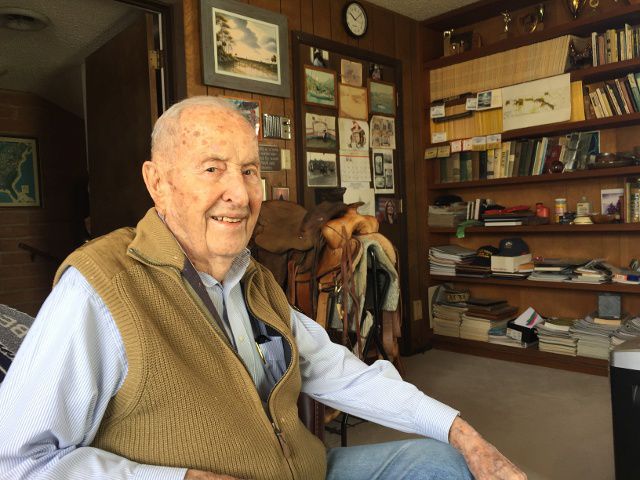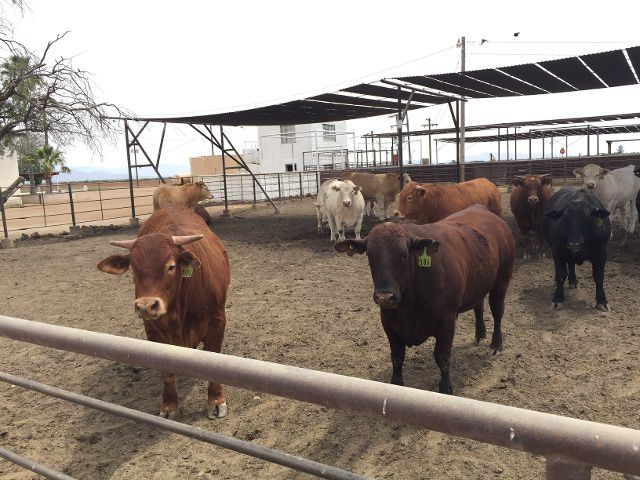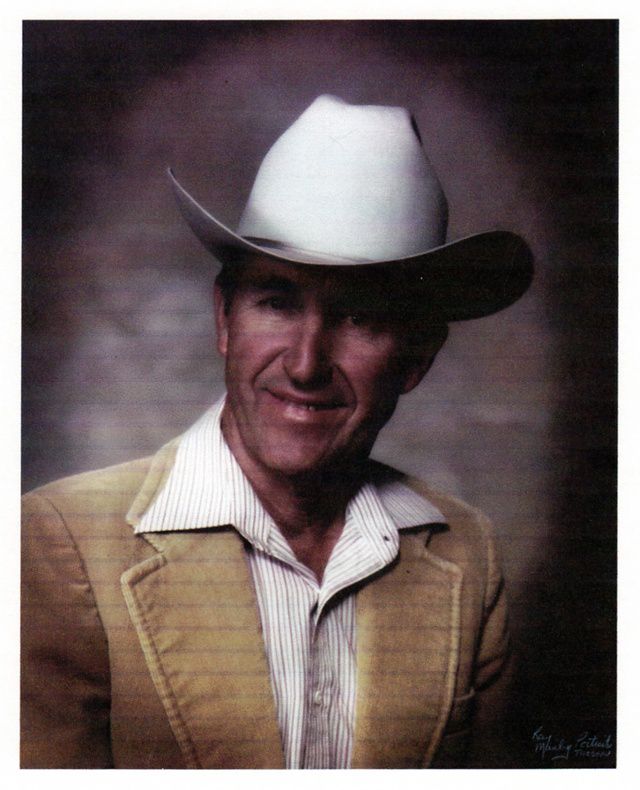Meet Arizona Agriculture’s Carl Stevenson
Published
4/18/2017
By Nancy Brandt, from Arizona Farming and Ranching Hall of Fame Executive Director Carole De Cosmo’s oral history interviews. Additional contributions by Janice Bryson and Julie Murphree: Although Carl Stevenson did not come from a ranching background it didn’t take long for him to develop a passion for working with livestock. Born in 1917 in Hollywood, California, Carl was the son of an attorney who died during the 1918 flu epidemic. His mother never remarried. At different times they lived with each of Carl’s grandparents until Carl’s maternal grandfather, a contractor by trade, built them a house in the San Fernando Valley where Carl grew up.

Carl Stevenson turns 100 this December. His family legacy in the beef industry represents a rich tradition.
“I went to the University of California at Davis,” he said. “I graduated in 1940. Graduated from high school in ’35.” Carl spent a couple of summers and whatever other time he could find in Chugwater, Wyoming working on a ranch. “I stayed out (of school) a couple of semesters in Alamosa, Colorado with a horse trader named Gil Traveler. We traded a lot of horses. I rode and broke a lot of horses for him.”
Not long after he graduated from college Carl was drafted into the Army. Less than a year later Pearl Harbor was bombed throwing the United States into the heart of the conflict. With his agricultural experience he was assigned to the veterinary corps, “which is a very small department in the Army,’ he remembers. “They sent ten of us to veterinary school for a ten-day crash course. I came out of that with a rating of
During his time at Fort
Their first stop was North Africa where Carl was assigned to work with the horse mounted Moroccan troops. He spent the winter of 1944-45 in Grenoble, France where he and ten men were assigned to provide a veterinary hospital behind Patton’s advancing tanks as they crossed the Rhine. Before war’s end, he served 4.5 years and had been in North Africa, Italy,
Discharged in 1945, Carl returned home and joined one of his UC Davis classmates working on a ranch in northern California.
In 1947 Carl and Pat were married and in 1951 the young couple and their three children moved to Continental, Arizona to become a part of the developing cattle feeding industry.
“Farmers Investment Company hired me in 1951 to come to Arizona and build a feed yard and then build a second feed yard,” he said. “We pastured cattle where Green Valley is today. It was all open country then and we ran a lot of cattle

Their feed yard can support 30,000 head of cattle and has been in operation since the 1960s.
When cattle prices dropped in 1963 Carl told his wife that if they were ever going to go back out on their own this would be a good time. He was sure that prices would
Not everyone thought he was making a wise decision. Carl had a packer in Los Angeles by the name of Joe Goldstein to whom he sold most of the cattle from Continental. “We had become friends, mostly over the phone.” When Carl told him where he was setting up shop Joe didn’t think the prospects sounded very promising. “He flew into Tucson, rented a car, drove out here and looked this property and got a hold of me and said, ‘Carl, you don’t want to go there. That’s the worst place in the world.’ I
In the early days, as he was working to build the business Carl got a call from one of the Greenough brothers in Wyoming? “He knew I was building this feed yard. He said, Carl, I’ve got three loads on the way for you. I’ll get you started. I said I haven’t got anything ready to feed yet.” To that Greenough replied, “Well that’s your problem. They’re on the way.” Not one to let grass grow under his feet, Carl bought a couple of semi loads of feed from another feedlot and fed them until he got going. When Joe Goldstein came back and looked at what Carl was accomplishing he said, “Well, you’ve really done it. Let’s feed some cattle. I’ll partner with you.” Carl told him that he didn’t have the money to buy cattle yet but that didn’t deter Goldstein. He told Carl that was ok. He still wanted to partner with him. “He fed a lot of cattle over the years with me.” Carl said, “I could get cattle about as fast as I could build pens so we kept enlarging it. We never borrowed any money to enlarge. We just did it on our cash flow. We started out with five or six hundred cattle and we got up to 28,000.” He pastured cattle as far away as the Chino Valley area and Willcox.

Carl's service to the agriculture industry spans decades and represents
The feed being used by cattle feeders in Arizona at the time was considered to be a little inferior to what some other areas were feeding. “We don’t have corn in this country like the rest of them do, but we have a lot of Milo and sorghum grown here and that’s what we were feeding lots of.” In 1961-62, Dr. Bill Hale of the University of Arizona was experimenting with a new way of flaking grain.
“He decided that if he could properly process, steam cook it and flake it he could get the same food value out of it because it has more protein than even corn. So he worked on that and he came down and we worked together on it. I would try it at the feed yard. It got to where I had everything. I put in a cooking system and a flaking system down at Continental and we were steam flaking grain the way he had developed it. I must say that I think he was the first to do that and I think we were
Bruce Taylor was hired as dean of the Department of Agriculture at the University of Arizona in the ‘50s and he and Carl developed a friendship. “He wanted to try feeding fat because we had a little rendering works in Tucson. They really had no outlet for fat so we could buy it real cheap. It has about 2 ¼ times the energy of corn or grain so we started feeding fat then. We developed feeding fat and rolled grain through Dr. Hale. He’s been recognized really over the world for it.”
Pat died of cancer in 1971. Carl established an endowment and scholarship at the University of Arizona in her name. Then a few years later Carl found love a second time when he married Betty Schroeder.
In the 1980s Carl was one of the leaders of a movement to merge the Arizona Cattle
Today his son does most of the heavy work but Carl still works on the feedlots. “My son spent some time rodeoing. He’s quite a roper, one of the best. When he quit being on the rodeo circuit he came home and said I’m ready to go to work, and that’s about all he’s ever done since. We get together two or three times a week and discuss what we might be doing and buying and selling. We ship 18 to 20 loads of fat cattle every week and we don’t try to play the market. We ship them every week. Get the best we can. We buy most of our cattle out of Mexico.”
Explain your agribusiness operation(s): Our family has been in the cattle feeding business since the 1960s. We started out small and grew to what we are today. We also have acreage that we lease to others. I learned everything I could learn about the feeder business when Keith Walden of Farmers Investment Company offered me an opportunity in 1951 to come to Continental, Arizona and start a cattle feeding operation for them. I had done some feeding in California. [Continental Feed Yard grew and a second yard was built eight miles away in Sahuarita. The two yards had the capacity of 18,000 head.]
Any practices or other special practices in your area improved the feeding Industry? Thanks to
What is your educational background? I graduated in 1940 from the University of California, Davis from the College of Agriculture. A year later I was in the Army.
Share other honors you’ve received over the years: To list,
- Red Rock Feeding Company was named #96 or the Top 100 Arizona Private Companies by the Phoenix Chamber of Commerce
- Lifetime Achievement Award – University of Arizona
- Outstanding Agriculturist (livestock) – Ag 100 Council
- Cattleman of the Year – Arizona Cattle Growers Association
Affiliations?
- Arizona Beef Council – Past Chairman
- Arizona Cattle Industry Research & Education Foundation – Past Chairman
- Advisory Board of the Federal Government’s mandated environmental act. Appointed by Governor.
- Ag 100 Council
- Presidents Council
- The Arizona Cattle Feeders Association, Past Chairman
- National Cattleman’s Beef Association
- Arizona Cattle Growers Association
- Arizona Farm Bureau
- Arizona State Cowbelles 500 Club
- Mountain Oyster Club, Tucson – Member, Past President
What do you love the most about farming, ranching, or the agriculture industry in general? According to Janice Bryson in the October 2011 issue of Arizona Cattlemen’s Association, “Carl believes that by the nineteen sixties Arizona was leading the U.S. in the expertise in cattle feeding. Our state had the first large-scale commercial feed yards and was out front in processing grain and formulating the best rations. The University of Arizona deserves a great deal of credit with their feed formula.”
What about the next generation? From Janice Bryson’s Profile on Carl: “Carl and Pat were parents of four children who have remained involved in agriculture.
What do you enjoy doing, and what is one fact/achievement that nobody knows about you? I’ve reached the top of Mt. Whitney of the High Sierras in California twice. Over the years, I’ve sailed too.
How will the next generation of agriculturalists have to operate? I’ve always told my kids that they need to learn and know how to do things yourselves.
Postscript: When interviewing last week Mr. Stevenson and posting photos on social media, here is a list of comments from friends.
- Sue Krentz: One of my favorites this is one of the perks belonging to Cattle growers you have Amazing friends
- Kate Feenstra DeZeeuw: Whisks me back to our farm in Minnesota...my heritage n still in my blood! Finally had to sell our cattle after hubby was diagnosed with Parkinson's disease...only have chickens left, the best, ever eggs remain our breakfast staple.
- Tracie Moore Loughhead: I had the pleasure of working at Red Rock Feeding several years ago. I love the industry.
- Jeri Murrieta: Back in the '70's my husband built/weld several pens there.
- Diana Kessler: An amazing family and legacy!!! My husband worked there on weekends when in school at UofA.
- Micaela McGibbon: Love the family! So much knowledge and love for the industry and all that are in it!
- Deb Walden-Ralls: I have known Carl all my life. He ran our feedlot here in Continental before starting his. Wonderful family!
Editor’s Note: Many thanks to Nancy Brandt, Carole De Cosmo and Janice Bryson for capturing the rich history of another long-time farm and ranch family